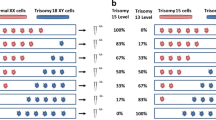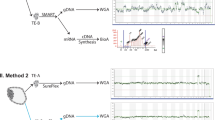Abstract
Purpose
To assess the accuracy and reliability of comprehensive chromosome screening by next-generation sequencing (NGS) of human trophectoderm (TE) biopsy specimens.
Methods
The reliability and accuracy of diagnoses made by preimplantation genetic testing for aneuploidy (PGT-A) from TE biopsy were tested. Repeat biopsies of TE and inner cell mass (ICM) samples were obtained from thawed blastocysts previously tested by NGS. To test for the reliability of the NGS assay, biopsy samples were compared with the original PGT-A results. Prior NGS testing classified the TE samples as euploid, aneuploid, or aneuploid-mosaic. The resulting re-biopsied samples underwent SurePlex whole genome amplification followed by NGS via the MiSeq platform, with copy number value (CNV) determined using BlueFuse Multi Software. The primary outcome measure was reliability, defined as concordance between initial TE result and the repeat biopsies. Accuracy was determined by concordance between the TE and ICM samples, and compared between three chromosome types (disomic, aneuploid, and mosaic).
Results
Re-biopsies were performed on 32 embryos with prior PGT-A showing euploidy (10 embryos), aneuploidy of one or two chromosomes (4 embryos), or aneuploid-mosaic with one aneuploid chromosome and one mosaic chromosome (18 embryos). One hundred twenty-nine biopsy samples completed NGS (90 TE and 39 ICM biopsies) and 105 biopsy results were included in the analysis. TE biopsies provide a highly accurate test of the future fetus, with the ICM disomic concordance rate of 97.6%. Clinical concordance rates indicate that TE biopsies provide a reliable test when the result is euploid (99.5%) or aneuploid (97.3%), but less reliable when the result is mosaic (35.2%).
Conclusion
TE biopsies predict euploidy or aneuploidy in the ICM with a high degree of accuracy. PGT-A with NGS of TE biopsies is shown to be highly reliable, with clinically relevant concordance rates for aneuploidy and euploidy over 95%. TE biopsies indicating mosaicism were less reliable (35.2%), presumably because mitotic non-disjunction events are not uniformly distributed throughout the blastocyst. However, classification of TE biopsy of PGT-A with NGS results as either aneuploid or euploid provides a highly reliable test.

Similar content being viewed by others
References
Hassold TaH P. To err (meiotically) is human: the genesis of human aneuploidy. Nat Rev Genet. 2001;2:280–91.
Munné S, Weier H, Grifo J, Cohen J. Chromosome mosaicism in human embryos. Biol Reprod. 1994;51(3):373–9.
Munne S, Lee A, Rosenwaks Z, Grifo J, Cohen J. Diagnosis of major chromosome aneuploidies in human preimplantation embryos. Hum Reprod (Oxford, England). 1993;8(12):2185–91.
Schoolcraft WB, Fragouli E, Stevens J, Munne S, Katz-Jaffe MG, Wells D. Clinical application of comprehensive chromosomal screening at the blastocyst stage. Fertil Steril. 2010;94(5):1700–6. https://doi.org/10.1016/j.fertnstert.2009.10.015.
Malvestiti F, Agrati C, Grimi B, Pompilii E, Izzi C, Martinoni L, et al. Interpreting mosaicism in chorionic villi: results of a monocentric series of 1001 mosaics in chorionic villi with follow-up amniocentesis. Prenat Diagn. 2015;35(11):1117–27. https://doi.org/10.1002/pd.4656.
Maxwell SMGJ. Should every embryo undergo preimplantation genetic testing for aneuploidy? A review of the modern approach to in vitro fertilization. Best Pract Res Clin Obstet Gynaecol. 2018;53(Nov):38–47.
Cram DS, Leigh D, Handyside A, Rechitsky L, Xu K, Harton G, et al. PGDIS Position Statement on the Transfer of Mosaic Embryos 2019. Reprod BioMed Online. 2019;39(Supplement 1):e1–4.
Sachdev NMMS, Besser AG, Grifo JA. Diagnosis and clinical management of embryonic mosaicism. Fertil Steril. 2017;107(1):6–11.
Mantikou E, Wong KM, Repping S, Mastenbroek S. Molecular origin of mitotic aneuploidies in preimplantation embryos. Biochim Biophys Acta. 2012;1822(12):1921–30. https://doi.org/10.1016/j.bbadis.2012.06.013.
Kung A, Munne S, Bankowski B, Coates A, Wells D. Validation of next-generation sequencing for comprehensive chromosome screening of embryos. Reprod BioMed Online. 2015;31(6):760–9. https://doi.org/10.1016/j.rbmo.2015.09.002.
Friedenthal JMS, Munné S, Kramer Y, McCulloh DH, McCaffrey C, Grifo JA. Next generation sequencing for preimplantation genetic screening improves pregnancy outcomes compared with array comparative genomic hybridization in single thawed euploid embryo transfer cycles. Fertil Steril. 2018;109(Apr):627–32.
Greco E, Minasi MG, Fiorentino F. Healthy babies after intrauterine transfer of mosaic aneuploid blastocysts. N Engl J Med. 2015;373(21):2089–90. https://doi.org/10.1056/NEJMc1500421.
Munne SBJ, Large M, Martinez-Ortiz PA, Nisson H, Liu E, Tarozzi N, et al. Detailed investigation into the cytogenetic constitution and pregnancy outcome of replacing mosaic blastocysts detected with the use of high-resolution next-generation sequencing. Fertil Steril. 2017;108(1):62–71.
Helen Bolton SJLG, Van der AA N, Kumar P, Theunis K, Gallardo EF, Voet T, et al. Mouse model of chromosome mosaicism reveals lineage-specific depletion of aneuploid cells and normal developmental potential. Nat Commun. 2016;7(7):1165.
Vera-Rodriguez M, Rubio C. Assessing the true incidence of mosaicism in preimplantation embryos. Fertil Steril. 2017;107(15):1107–12.
Capalbo A, Wright G, Elliott T, Ubaldi FM, Rienzi L, Nagy ZP. FISH reanalysis of inner cell mass and trophectoderm samples of previously array-CGH screened blastocysts shows high accuracy of diagnosis and no major diagnostic impact of mosaicism at the blastocyst stage. Hum Reprod (Oxford, England). 2013;28(8):2298–307. https://doi.org/10.1093/humrep/det245.
Illumina. Veriseq PGS-MiSeq QC Assessment Guide. 2014.
Grati FRGG, Branca L, Maggi F, Simoni G, Yaron Y. An evidence-based scoring system for prioritizing mosaic aneuploid embryos following preimplantation genetic screening. Reprod Biol Endocrinol. 2018;2018(36):442–9.
Munné SWD. Detection of mosaicism at blastocyst stage with the use of high-resolution next-generation sequencing. Fertil Steril. 2017;107(5):1085–91.
Munné SSF, Grifo J, Zhang J, Beltran MP, Fragouli E, Fiorentino F. Clinical outcomes after the transfer of blastocysts characterized as mosaic by high resolution next generation sequencing- further insights. Eur J Med Genet. 2020;63(2):103741.
Gleicher N, Metzger J, Croft G, Kushnir VA, Albertini DF, Barad DH. A single trophectoderm biopsy at blastocyst stage is mathematically unable to determine embryo ploidy accurately enough for clinical use. Reprod Biol Endocrinol. 2017;15(1):33. https://doi.org/10.1186/s12958-017-0251-8.
Scott RT, Ferry K, Su J, Tao X, Scott K, Treff NR. Comprehensive chromosome screening is highly predictive of the reproductive potential of human embryos: a prospective, blinded, nonselection study. Fertil Steril. 2012;97. https://doi.org/10.1016/j.fertnstert.2012.01.104.
Goodrich D, Tao X, Bohrer C, Lonczak A, Xing T, Zimmerman R, et al. A randomized and blinded comparison of qPCR and NGS-based detection of aneuploidy in a cell line mixture model of blastocyst biopsy mosaicism. J Assist Reprod Genet. 2016;33(11):1473–80. https://doi.org/10.1007/s10815-016-0784-3.
Huang J, Yan L, Lu S, Zhao N, Qiao J. Re-analysis of aneuploidy blastocysts with an inner cell mass and different regional trophectoderm cells. J Assist Reprod Genet. 2017;34(4):487–93. https://doi.org/10.1007/s10815-017-0875-9.
Victor ARTJ, Brake AJ, Lepkowsky LT, Murphy AE, Griffin DK, McCoy RC, et al. One hundred mosaic embryos transferred prospectively in a single clinic: exploring when and why they result in healthy pregnancies. Fertil Steril. 2019;2019(111):280–93.
Victor AR, Griffin DK, Brake AJ, Tyndall JC, Murphy AE, Lepkowsky LT, et al. Assessment of aneuploidy concordance between clinical trophectoderm biopsy and blastocyst. Hum Reprod. 2019;34(1):181–92.
Lawrenz B, El Khatib I, Liñán A, Bayram A, Arnanz A, Chopra R, et al. The clinicians’ dilemma with mosaicism—an insight from inner cell mass biopsies. Hum Reprod. 2019;34(6):998–1010.
Author information
Authors and Affiliations
Additional information
Publisher’s note
Springer Nature remains neutral with regard to jurisdictional claims in published maps and institutional affiliations.
Rights and permissions
About this article
Cite this article
Sachdev, N.M., McCulloh, D.H., Kramer, Y. et al. The reproducibility of trophectoderm biopsies in euploid, aneuploid, and mosaic embryos using independently verified next-generation sequencing (NGS): a pilot study. J Assist Reprod Genet 37, 559–571 (2020). https://doi.org/10.1007/s10815-020-01720-x
Received:
Accepted:
Published:
Issue Date:
DOI: https://doi.org/10.1007/s10815-020-01720-x




